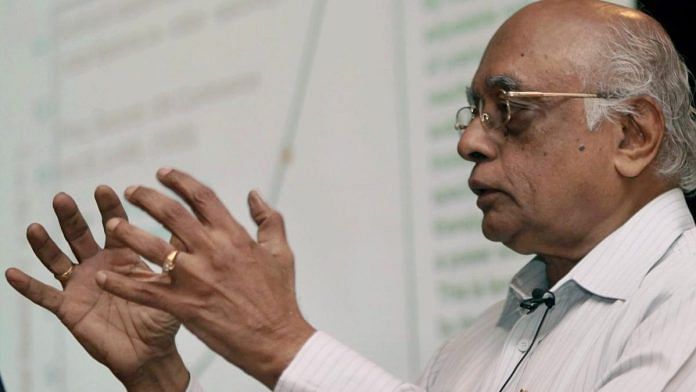New Delhi: At 3.45 pm on 11 May 1998, India conducted the first three of five planned nuclear tests of advanced weapon designs in Pokhran, Rajasthan. While these tests did not bode well with many of the ‘nuclear-weapon states’ who went on to place numerous sanctions on India, the man behind these tests, Rajagopala Chidambaram, knew this was a critical step in ensuring India’s strategic self-reliance.
Chidambaram, rightly known as one of the architects of India’s nuclear weapons programme for his contributions to the 1974 and 1998 atomic tests, breathed his last at Mumbai’s Jaslok Hospital Saturday. He was 88.
“It is with profound sorrow that we announce the passing of Dr Rajagopala Chidambaram, an eminent physicist and one of India’s most distinguished scientists, this morning (4 January 2022) at 3.20 am,” Department of Atomic Energy said in a statement announcing its former chief’s death.
Condolences poured in from politicians, colleagues and admirers, celebrating the veteran scientist’s contributions. “He was one of the key architects of India’s nuclear programme and made ground-breaking contributions in strengthening India’s scientific and strategic capabilities,” PM Narendra Modi said in a post on ‘X’.
Remembering his predecessor’s long list of achievements, Professor K. Vijayraghavan, former principal scientific advisor to the Government of India, said Chidambaram—who held the position of PSA from 2001 to 2018—“significantly advanced India’s nuclear capabilities and energy security”.
“His initiatives as principal scientific adviser, such as establishing the Core Advisory Group for R&D in various technology sectors, creation of the National Knowledge Network, and creating Rural Technology Action Groups, continue to impact India’s scientific landscape,” he added.
Vijayraghavan also said that Chidambaram’s passing marks the “end of an era in Indian science and technology of an individual who connected the earliest stages of India’s modern science to the present”.
Also Read: How Pokhran nuclear tests kicked off a year that changed India-Pakistan ties forever
Life & work of Rajagopala Chidambaram
Born in November 1936, the celebrated physicist completed his BSc in physics from Madras University in 1956 and went on to do his Masters in the subject from the same institute.
In 1962, he completed his PhD from the Indian Institute of Science in Bengaluru and joined the Atomic Energy Establishment (AEET) under the leadership of Homi J. Bhabha, ‘father of the Indian nuclear programme’.
Playing a significant role in India’s nuclear programme, Chidambaram was a part of the test preparations for Pokhran-I in 1974 and Pokhran-II in 1998. For a large part of his career, the doyen was a part of the government’s Department of Atomic Energy and led efforts in designing and executing nuclear devices for the tests.
Sharing anecdotes of Chidambaram’s passion for the project, Vijayraghavan narrated, “After 1988, when some faculty members at one of the Department of Atomic Energy’s institutions raised concerns, Chidambaram respectfully acknowledged their position but pointed out that unless there was complete nuclear disarmament, the demand that India not develop nuclear deterrence was not, in his view, a tenable position.”
Chidambaram’s involvement in the nuclear programme was such that during the 1974 nuclear test—dubbed Operation Smiling Buddha—he personally accompanied plutonium needed for the tests from Mumbai to Pokhran.
During the Pokhran tests of 1998, remembered as one of India’s best-kept secrets, he, along with former President and then head of the Defence Research Development Organisation (DRDO) Dr A.P.J. Abdul Kalam, spent several nights sleeping in the open in the gruelling summer of the Thar Desert.
After the tests, Prime Minister Atal Bihari Vajpayee declared India a nuclear state. The tests also confirmed that there was no radioactive contamination of the site, as was feared by some in his own department.
“Dr Chidambaram was a doyen of science and technology whose contributions furthered India’s nuclear prowess and strategic self-reliance. His loss is an irreparable one for the scientific community and the nation,” Ajit Kumar Mohanty, secretary of the Department of Atomic Energy, said.
Apart from his involvement in the nuclear programme, Chidambaram also steered India in the fields of nano-electronics, implemented the National Knowledge Network and played a pivotal role in setting up the Rural Technology Action Group (RuTAG) to find rural applications for advanced technologies.
For his contributions to the field of science and technology, he won several accolades, including the Padma Shri in 1975 and Padma Vibhushan in 1999—two among India’s highest civilian honours.
Colleagues and politicians who worked with Chidambaram said his contributions in the field of science, technology and atomic energy shaped modern India and will remain a part of India’s development history forever.
Senior Congress leader Jairam Ramesh remembered Chidambaram to be intellectually active and involved till his final days.
“Educated entirely in the country, he had a formidable global reputation in nuclear physics. But he was more than a nuclear physicist. He was a man of great learning and erudition in diverse disciplines,” Ramesh said.
Ramesh recalled how meeting and listening to Chidambaram was “always a deep education.”
India would fondly remember the scientist extraordinaire for his service to the nation. Still, for people who knew him personally, he goes as a “scientist with a sense of humour” who was “very, very rare”.
(Edited by Amrtansh Arora)
Also Read: 50 years of India being a self-reliant nuclear power. What the next govt should focus on






